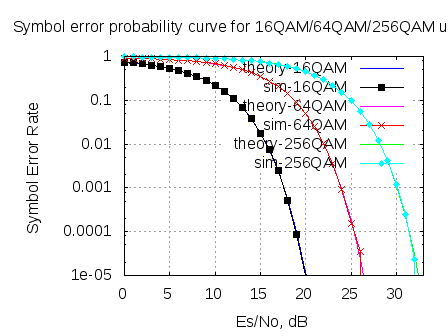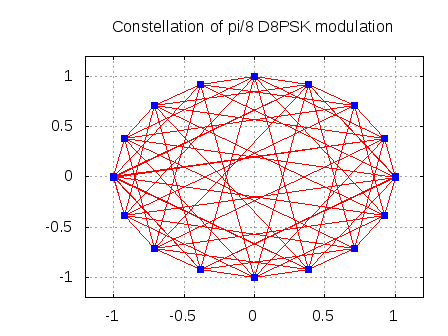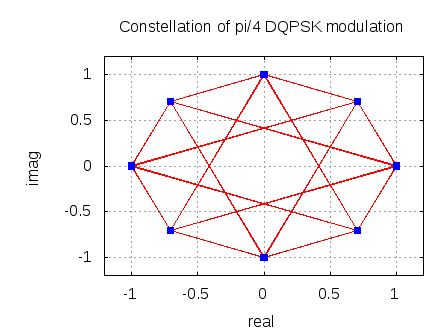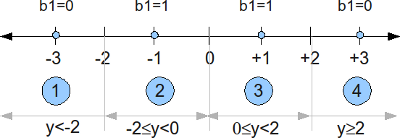In this post, let us try to understand Gray codes and their usage in digital communication. Quoting from Wiki entry on Gray code [Gray-Wiki],
The reflected binary code, also known as Gray code after Frank Gray, is a binary numeral system where two successive values differ in only one digit.
In a digital communication system, if the constellation symbols are Gray encoded, then the bit pattern representing the adjacent constellation symbols differ by only one bit. We will show in another post that having this encoding structure gives a lesser probability of error than the ‘natural binary ordering’. However, in this post, let us try to figure out the conversion of natural binary representation to Gray code.
Conversion from natural Binary to Gray code
Consider a bit binary number
with
representing the index of the binary number. Let
be the equivalent Gray code.
1. For ,
i.e, the most significant bit (MSB) of the Gray code is same as the MSB of original binary number.
2. For ,
i.e,
bit of the Gray code is the exclusive-OR (XOR) of
of the bit of the binary number and
of the bit of the binary number.
Simulation
Simple Matlab/Octave code for doing the binary to Gray code conversion
clear;
ip = [0:15]; % decimal equivalent of a four bit binary word
op = bitxor(ip,floor(ip/2)); % decimal equivalent of the equivalent four bit gray word
Table : Natural Binary to Gray code
| Input, decimal |
Input, binary |
Gray, decimal |
Gray, Binary |
| 0 | 0000 | 0 | 0000 |
| 1 | 0001 | 1 | 0001 |
| 2 | 0010 | 3 | 0011 |
| 3 | 0011 | 2 | 0010 |
| 4 | 0100 | 6 | 0110 |
| 5 | 0101 | 7 | 0111 |
| 6 | 0110 | 5 | 0101 |
| 7 | 0111 | 4 | 0100 |
| 8 | 1000 | 12 | 1100 |
| 9 | 1001 | 13 | 1101 |
| 10 | 1010 | 15 | 1111 |
| 11 | 1011 | 14 | 1110 |
| 12 | 1100 | 10 | 1010 |
| 13 | 1101 | 11 | 1011 |
| 14 | 1110 | 9 | 1001 |
| 15 | 1111 | 8 | 1000 |
Note
1. As can be seen from the Table above, each row differs from the row above and below by only one bit. Further, just to highlight that this behavior is indeed true for 16th row [1000] and the 1st row [0000] .
2. The conversion shown in the Table above can be used for general modulation schemes like M-PSK (Phase Shift Keying), M-PAM (Pulse Amplitude Modulation) etc.
3. However, for a general M-QAM modulation the binary to Gray code conversion is bit more complicated (and I need to figure that out). We will discuss the QAM case in a future post.
Thanks, Krishna



i have a little problem in the conversion illustrated above???
What to do if the binary number is not a simple binary number but a binary including the decimal???
For example what would be the gray code of 110101.101101???
Today i got this question in my engineering exam…???
i am in a great doubt…so please help me???
@Evolution: Well, can’t one ignore the decimal point (not sure though)?
Thanks a lot. Your method is fundamental and helps to understand the conversion properly.
@Rishu: Thanks, glad to help.
Dear Sir,
Kindly send me the free e-book on AWGN, I am already a memebr.
Thankyou
Vijay
@vijay: I emailed you the details.
Yes, i agree (strange) !
Disregarding the way of implementation of bitshift/floor under Matlab/Octave, it is well known that (Bit Shifting) is faster than any multiplication/division method, specially on microprocessors.
@O.S.O: I agree 🙂
Great job 😉
i just wanted to mention that this snippet :
op = bitxor(ip,floor(ip/2));
can be more optimized by just doing a right-shift bit by 1.
so the equivalent code would be :
bitxor(ip,bitshift(ip,-1));
-1 means a 1 bit shift to the right (the negative sign means right).
@O.S.O: Thanks for the tip. However, I did a quick experiment with octave using tic-toc and did not observe that using bitshift() instead of floor is faster.
octave:51> clear all; tic; ip = [0:2^20-1];op = bitxor(ip,floor(ip/2));toc
Elapsed time is 0.4 seconds.
octave:52> clear all; tic;ip1 = [0:2^20-1];op1 = bitxor(ip1,bitshift(ip1,-1));toc
Elapsed time is 0.46 seconds.
Agree?
i liked your method of conversion very much.
so
thanks
@elizabeth: Well, you can use the steps 1, 2 in “Conversion from natural Binary to Gray code” to write your own code. No?
i am doing engg…. thanks for the quick reference…. please also include how to do it in order… egs why does the 1001 follow 1011..how should we write it on our own….. in a sequence such that we can make a tabulation table to draw the logic diagram of a code converter from binary to grey etc!